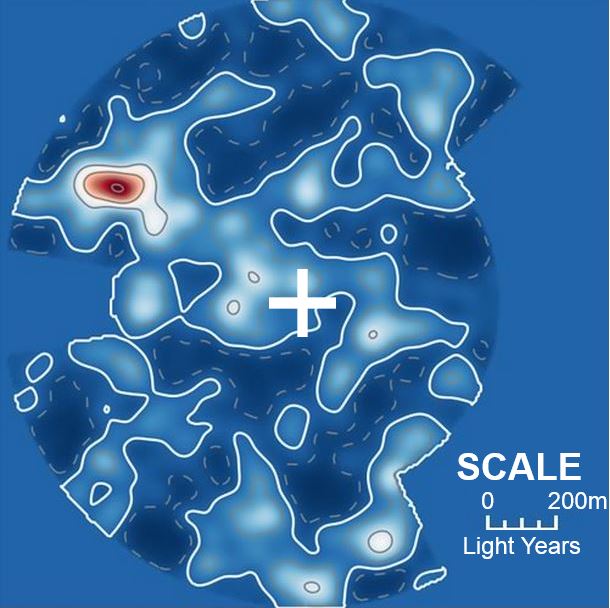The most comprehensive 3D map of the Universe has been created by astrophysicists from Canada and France, who say it spans almost two billion light years and provides the most complete picture of our cosmic neighbourhood to date.
The scientists say their spherical map of galaxy superclusters will help provide a better understanding of how matter is distributed across the universe, as well as some of the features of dark matter, one of the greatest mysteries in the world of physics.
Prof. Mike Hudson, Stephen Turnbull and Jonathan Carrick, of the University of Waterloo’s Department of Physics and Astronomy, and Guilhem Lavaux of the Institut d’Astrophysique de Paris, created the map.

A slice through the 3D map of the nearby universe. Our Milky Way is the white cross in the centre. (Image: uwaterloo.ca)
Prof. Hudson, who is also associate Dean of Science and Computing, said:
“The galaxy distribution isn’t uniform and has no pattern. It has peaks and valleys much like a mountain range. This is what we expect if the large-scale structure originates from quantum fluctuations in the early universe.”
The scientists wrote about their achievement in the prestigious academic journal Monthly Notices of the Royal Astronomical Society (citation below).
The white and lighter blue areas on the map represent parts of the universe with greater concentrations of galaxies. The red area is the Shapley Concentration, a supercluster – the largest collection of galaxies in the nearby universe. Areas that remain to be explored appear in medium blue.
Expansion of the universe and dark matter
Knowing where matter is and how it is moving in the universe will help scientists forecast the universe’s expansion, and identify where and how much dark matter there is.
Galaxies move differently, the astrophysicists say, because the universe’s expansion is not even.
These different rates of movement are called peculiar velocities. Our own galaxy, the Milky Way, and our neighbour Andromeda are moving at 2 million kilometres per hour.
Previous models have not fully factored in this observed motion. Prof. Hudson and colleagues would like to find out what structures are driving these peculiar velocities.
The authors wrote:
“These deviations in the motion of galaxies are a valuable tool to determine the distribution of matter and dark matter on the largest scales.”
Dark matter refers to material we cannot detect in the universe by its emitted radiation, but whose presence can be inferred from its gravitational effects on visible matter, like galaxies and stars. Scientists say that most of the mass in the universe consists of dark matter.
In other words, we know dark matter is there even though we cannot see it, because it pulls things we can see (it has gravity). It also has an effect on light.
Prof. Hudson said:
“A better understanding of dark matter is central to understanding the formation of galaxies and the structures they live in, such as galaxy clusters, superclusters and voids.”
The scientists, together with a team of Australian astrophysicists now plan to gather more detailed samples of peculiar velocities to enhance the map.
Citation: “Cosmological parameters from the comparison of peculiar velocities with predictions from the 2M++ density field,” Jonathan Carrick, Stephen J. Turnbull, Guilhem Lavaux and Michael J. Hudson. Published 16 April, 2015. Monthly Notices of the Royal Astronomical Society. DOI: 10.1093/mnras/stv547.
Video – The Universe
Guilhem Lavaux says the movie shows a 3D Map of the nearby Universe, where they took successive slices. The volume they have mapped is roughly circular, so its a bit like slicing an orange vertically from the edge through to the opposite edge. Our Milky Way Galaxy is in centre of the middle frame (marked SGZ=0) halfway through the movie.

